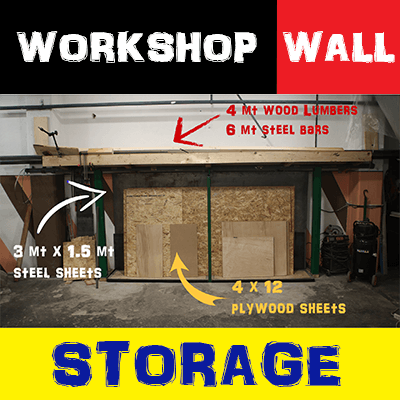INTRODUCTION
Ciao I’m The Cuz and this is The Cuz Does, the unconventional DIY blog.
For who doesn’t know I’m building from scratch my Workshop, My DEN, and in this post, I will share whit you how I’ve improved my lighting system.
I decided to do pass trough this step because my lighting was poor, flagging and most of all it wasn’t good enough to make good quality videos for my YouTube channel.
So I decided to build a brand new lighting system from scratch.
STARTING FROM THEORY – LIGHT MEASURING UNIT
First of all, we need to know some measuring units to better understand the process behind a lighting system design.
Lumen
The measuring unit of light amount is the lumen. This parameter indicates the amount of light that a bulb can provide.
Ligh Temperature
Another important parameter to consider is light temperature because it indicates how much warm light is and also the light color provided by a lamp. It is measured in Kelvin and works as follow:
-
- 3000 K = warm light = yellow light
- 4000 / 4500 K = Day Light = natural colors
- 6000 K = cold light = white light
Lux
If you searched for the correct amount of light according to your activities needs, you have surely find another unit LUX. This is nothing more than the lumens provided by a lamp per square meter.
CRI
Finally, the last one, is the COLOR RENDERING INDEX. This parameter indicates how bright and natural colors will appear. This was very important to me because, as a YouTuber, I could not have bad colors appearance while filming.
PUT EVERYTHING TOGETHER
After we understood all these parameters, we have to ask ourselves: how do I put all these informations together to calculate the right amount of light and bulbs needed?
The answer is THE LUX METHOD.
This is a mathematical method I am not going to dig in because it is very easy to find tutorials on YouTube that would explain it better than I can do. However, it is important to know it because, depending on the worktops’ height, the general space dimensions and the luminous capacity of our lamps, it returns the number of lamps needed to illuminate your space correctly.
To have a more efficient result also according to the daylighting available I used a free software called Dialux to make those technical calculations
This FREE software allows you to import or draw your Floor plan and, thanks to a huge lamps database, simulate the amount of lux available. if you want to go check of does it work you can download the software from this link:
https://www.dial.de/en/dialux-desktop/download/
After you download the software go check my YouTube channel to see my step by step tutorial on HOW I DESIGNED AND REALIZED MY LIGHTING SYSTEM FROM SCRATCH @:
https://www.youtube.com/channel/UCS0GGI8QZDJLbdpkXn7O8Pw
PRESCRIPTIONS
Lots of you will say: Why all these problems for lighting systems?
This is necessary because of these for two main reasons:
-
- Europe and specifically in Italy there are regulations that provide for a minimum number of lux for each type of activity.
- Because I own a DIY YouTube channel, quantity and quality of “lighting” is certainly fundamental.
For this reason, I recommend a small in-depth study of “lighting prescriptions” to anyone who has found himself to face this problem.
CONCLUSIONS
As mentioned before as a YouTuber, quality and quantity of light are too much important to me. Another even more strong consideration, due to climate change and billing problems was efficiency. For this reason, I chose LED neon lamps with watertight ceilings.
In this way, I can reach 97 CRI and have a total power consumption of 900 W
Everything will be plugged into 3 main circuits to make sure I have the best combination of sunlight and artificial light possible.
#whatdoyousuggest
what you would have done differently? please let me know in the comment section below. I will consider any corrective or upgrading proposal and reply to all the comments I can.
Ciao from TheCuz!




